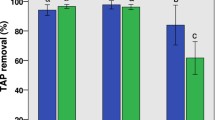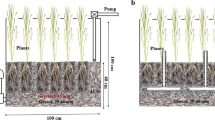Abstract
Fluopyram is a novel broad-spectrum fungicide with nematocidal activity, and as an extensively used pesticide, it could cause toxicity in nontarget organisms. The aim of this study was to explore the efficiency of five horizontal subsurface flow (HSF) constructed wetlands (CWs) to remove fluopyram from rinsing water produced during the cleaning of pesticide spraying equipment. Four CWs, namely WG-R, WG-R-P, WG-C, and WG-U, contained fine gravel as porous media. WG-R and WG-R-P were planted with Phragmites australis, WG-C with Typha latifolia, and WG-U was left unplanted. Bioaugmentation with plant growth-promoting rhizobacteria was conducted in WG-R-P unit. The fifth unit (WGZ-R) planted with Phragmites australis and contained gravel and zeolite as porous media. All of CWs were loaded on a daily basis from December 2019 to January 2021 with water fortified with fluopyram. The removal rate follows the pattern of WG-R-P (70.67%) > WGZ-R (62.06%) > WG-C (59.98%) > WG-R (36.10%) > WG-U (25.09%). The most important parameters affecting the fluopyram removal were bioaugmentation, zeolite presence in porous media, and plant species. The WG-R-P unit showed higher fluopyram removal in comparison to the WG-R (increase about 96%), the zeolite increased the fluopyram removal by 72%, and the WG-C unit showed 66% higher fluopyram removal than the WG-R unit.





Similar content being viewed by others
Data availability
The datasets used and/or analyzed during the current study are available from the corresponding author on reasonable request.
References
Abedi T, Mojiri A (2019) Constructed wetland modified by biochar/zeolite addition for enhanced wastewater treatment. Environ Technol Innov 16:100472. https://doi.org/10.1016/j.eti.2019.100472
Adoko MY, Agbodjato NA, Ouikoun GC, Amogou O, Noumavo PA, Sina H, Koda AD, Allagbé M, Ahoyo Adjovi N, Adjanohoun A, Baba-Moussa L (2020) Inoculation of Pseudomonas putidain farmer environment to improve growth and yield: maize (Zea mays L.) trial in Sothern, Central and Northern (Benin). IJPSS 32(6):9–21. https://doi.org/10.9734/IJPSS/2020/v32i630288
Bauske MJ, Yellareddygari SKR, Gudmestad NC (2018) Potential impact of fluopyram on the frequency of the D123E mutation in alternaria solani. Plant Dis 102(3):656–665. https://doi.org/10.1094/PDIS-06-17-0853-RE
Ben Saad M, Ben Said M, Bousselmi L, Ghrabi A (2016) Application of bioinoculation to enhance rhizocompetence of horizontal subsurface flow constructed wetland system. Desalin Water Treat 57(46):22133–22139. https://doi.org/10.1080/19443994.2016.1141713
Bexfield LM, Belitz K, Lindsey BD, Toccalino PL, Nowell LH (2021) Pesticides and pesticide degradates in groundwater used for public supply across the United States: occurrence and human-health context. Environ Sci Technol 55(1):362–372
Button M, Nivala J, Weber KP, Aubron T, Müller RA (2015) Microbial community metabolic function in subsurface flow constructed wetlands of different designs. Ecol Eng 80:162–171
Chawla S, Patel DJ, Patel SH, Kalasariya RL, Shah PG (2018) Behaviour and risk assessment of fluopyram and its metabolite in cucumber (Cucumis sativus) fruit and in soil. Environ Sci Pollut Res 25(12):11626–11634. https://doi.org/10.1007/s11356-018-1439-y
Crites RW, Middlebrooks J, Reed SC (2006) Natural wastewater treatment systems. CRC Press, Taylor & Francis Group, Boca Raton
Directive 98/83/EC, 1998. Council Directive 98/83/EC of 3 November 1998 on the quality of water intended for human consumption, Off. J. Eur. Communities
Dong B, Hu J (2016) Photodegradation of the novel fungicide fluopyram in aqueous solution: kinetics, transformation products, and toxicity evolvement. Environ Sci Pollut Res 23:19096–19106. https://doi.org/10.1007/s11356-016-7073-7
Gaullier C, Baran N, Dousset S, Devau N, Billet D (2019) Wetland hydrodynamics and mitigation of pesticides and their metabolites at pilot-scale. Ecol Eng 136:185–192
Gikas GD, Pérez-Villanueva M, Tsioras M, Alexoudis C, Pérez-Rojas G, Masís-Mora M, Lizano-Fallas V, Rodríguez-Rodríguez CE, Vryzas Z, Tsihrintzis VA (2018a) Low-cost approaches for the removal of terbuthylazine from agricultural wastewater: constructed wetlands and biopurification system. Chem Eng J 335:647–656. https://doi.org/10.1016/j.cej.2017.11.031
Gikas GD, Vryzas Z, Tsihrintzis VA (2018b) S-metolachlor herbicide removal in pilot-scale horizontal subsurface flow constructed wetlands. Chem Eng J 339:108–116. https://doi.org/10.1016/j.cej.2018.01.056
Gikas GD, Sylaios GK, Tsihrintzis VA, Konstantinou IK, Albanis T, Boskidis I (2020) Comparative evaluation of river chemical status based on WFD methodology and CCME water quality index. Sci Total Environ 745:140849
Guο W, Zhang H, Huo H (2014) Organochlorine pesticides in aquatic hydrophyte tissues and surrounding sediments in Baiyangdian wetland, China. Ecol Eng 67:150–155
He H, Duan Z, Wang Z, Yue B (2017) The removal efficiency of constructed wetlands filled with the zeolite-slag hybrid substrate for the rural landfill leachate treatment. Environ Sci Pollut Res 24(21):17547–17555. https://doi.org/10.1007/s11356-017-9402-x
Hwang JI, Lee SE, Kim JE (2015) Interpretation and estimation for dynamic mobility of chlorpyrifos in soils containing different organic matters. Environ Geochem Hlth 37:1017–1027
Kadlec RH, Wallace SD (2009) Treatment Wetlands, 2nd edn. CRC Press, Taylor and Francis Group, Boca Raton
Karpouzas DG, Walker A (2001) Factors influencing the ability of Pseudomonas putida strains epI and II to degrade the organophosphate ethoprophos. J Appl Microbiol 89:40–48. https://doi.org/10.1046/j.1365-2672.2000.01080.x
Korosa A, Auersperger P, Mali N (2016) Determination of micro-organic contaminants in groundwater (Maribor, Slovenia). Sci Total Environ 571:1419–1431
López AA, Ramos M d MG, Fernandez-Alba AR (2014) Transformation products of pesticides in the environment: analysis and occurrence. In: Lambropoulou DA, Nollet LML (eds) Transformation Products of Emerging Contaminants in the Environment: Analysis. Processes, Occurrence, Effects and Risks, John Wiley and Sons Ltd, Boca Raton, pp 387–412
Lv T, Zhang Y, Casas ME, Carvalho PN, Arias CA, Bester K, Brix H (2016) Phytoremediation of imazalil and tebuconazole by four emergent wetland plant species in hydroponic medium. Chemosphere 148:459–466
Lv T, Carvalho PN, Zhang T, Zhang Y, Button M, Arias CA, Weber K, Brix H (2017) Functionality of microbial communities in constructed wetlands used for pesticideremediation: influence of system design and sampling strategy. Water Res 110:241–251
Matadha NY, Mohapatra S, Siddamallaiah L, Udupi VR, Gadigeppa S, Raja DP (2019) Uptake and distribution of fluopyram and tebuconazole residues in tomato and bell pepper plant tissues. Environ Sci Pollut Res 26(6):6077–6086. https://doi.org/10.1007/s11356-018-04071-4
Mekonnen TF, Panne U, Koch M (2018) New photodegradation products of the fungicide fluopyram: structural elucidation and mechanism identification. Molecules 23(11). https://doi.org/10.3390/molecules23112940
Menchen A, delas Heras J, Gómez Alday J (2017) Pesticide contamination in groundwater bodies in the Júcar River European Union Pilot Basin (SE Spain). Environ Monit Assess 189(146):1–18
Milke J, Gałczynska M, Wróbel J (2020) The importance of biological and ecological properties of Phragmites australis (Cav.) Trin. Ex Steud., in phytoremendiation of aquatic ecosystems:the review. Water 12:1770
Mishra I, Fatima T, Egamberdieva D, Kumar Aora N (2020) Novel bioformulations developed from Pseudomonas putida BSP9 and its biosurfactant for growth promotion of Brassica juncea (L.). Plants 9:1349. https://doi.org/10.3390/plants9101349
Moorehead KK, Reddy KR (1988) Oxygen transport through selected aquatic macrophytes. J Environ Qual 17:138–142
Onwona-Kwakyea M, Hogarh JN, Van den Brinkad PJ (2020) Environmental risk assessment of pesticides currently applied in Ghana. Chemosphere 254:1268452
Papadopoulou ES, Karas PA, Nikolaki S, Storck V, Ferrari F, Trevisan M, Tsiamis G, Martin-Laurent F, Karpouzas DG (2016) Dissipation and adsorption of isoproturon, tebuconazole, chlorpyrifos and their main transformation products under laboratory and field conditions. Sci Total Environ 569-570:86–96. https://doi.org/10.1016/j.scitotenv.2016.06.133
Papaevangelou VA, Gikas GD, Tsihrintzis VA (2016) Effect of operational and design parameters on performance of pilot-scale horizontal subsurface flow constructed wetlands treating university campus wastewater. Environ Sci Pollut Res 23:19504–19519
Papaevangelou VA, Gikas GD, Vryzas Z, Tsihrintzis VA (2017) Treatment of agricultural equipment rinsing water containing a fungicide in pilot-scale horizontal subsurface flow constructed wetlands. Ecol Eng 101:193–200. https://doi.org/10.1016/j.ecoleng.2017.01.045
PPDB (Pesticide Properties Data Base), 2016. Fluopyram general information, University of Hertfordshire, UK. https://sitem.herts.ac.uk/aeru/ppdb/en/Reports/1362.htm (accessed 6 March 2021)
Prosser RS, Hoekstra PF, Gene S, Truman C, White M, Hanson ML (2020) A review of the effectiveness of vegetated buffers to mitigate pesticide and nutrient transport into surface waters from agricultural areas. J Environ Manag 261:110210. https://doi.org/10.1016/j.jenvman.2020.110210
Rehman F, Pervez A, Khattak NB, Ahmad R (2018) Plant growth promoting rhizobacteria impact on Typha latifolia and Phragmites australis growth and dissolved oxygen. Clean (Weinh) 46:1700353. https://doi.org/10.1002/clen.201700353
Reichenberger S, Bach M, Skitschak A, Frede HG (2007) Mitigation strategies to reduce pesticide inputs into ground and surface water and their effectiveness: a review. Sci Total Environ 384(1-3):1–35. https://doi.org/10.1016/j.scitotenv.2007.04.046
Riva V, Riva F, Vergani L, Crotti E, Borin S, Mapelli F (2020) Microbial assisted phytodepuration for water reclamation: environmental benefits and threats. Chemosphere 241:1248432
Romain V, Sylvie D, David B (2015) Water residence time and pesticide removal in pilot-scale wetlands. Ecol Eng 85:76–84. https://doi.org/10.1016/j.ecoleng.2015.09.040
Sahin C, Karpuzcu ME (2020) Mitigation of organophosphate pesticide pollution in agricultural watersheds. Sci Total Environ 710:136261
Shahid MJ, Al-surhanee AA, Kouadri F, Ali S, Nawaz N, Afzal M, Rizwan M, Ali B, Soliman MH (2020) Role of microorganisms in the remediation of wastewater in floating treatment wetlands: a review. Sustainability 12(14):1–29. https://doi.org/10.3390/su12145559
Sicbaldi F, Sacchi GA, Trevisan M, Del Re AAM (1997) Root uptake and xylem translocation of pesticides from different chemical classes. Pest Manag Sci 50:111–119
Smalling KL, Kuivila KM, Orlando JL, Phillips BM, Anderson BS, Siegler K, Hunt JW, Hamilton M (2013) Environmental fate of fungicides and other current-use pesticides in a central California estuary. Mar Pollut Bull 73(1):144–153. https://doi.org/10.1016/j.marpolbul.2013.05.028
Syranidou E, Christofilopoulos S, Gkavrou G, Thijs S, Weyens N, Vangronsveld J, Kalogerakis N (2016) Exploitation of endophytic bacteria to enhance the phytoremediation potential of the wetland helophyte Juncus acutus. Front Microbiol 7:1016
Szekacs A, Mortl M, Darvas B (2015) Monitoring pesticide residues in surface and ground water in Hungary: surveys in 1990-2015. J Chemother 2015:1–15. https://doi.org/10.1155/2015/717948
Tang M, Zhang F, Yao S, Liu Y, Chen J (2015) Application of Pseudomonas flava WD-3 for sewage treatment in constructed wetland in winter. Environ Technol 36(9):1205–1211. https://doi.org/10.1080/21622515.2014.983183
Tsihrintzis VA, Gikas GD (2010) Constructed wetlands for wastewater and activated sludge treatment in North Greece: a review. Water Sci Technol 61(10):2653–2672
Tsihrintzis VA, Akratos C, Gikas GD, Karamouzis D, Angelakis AN (2007) Performance and cost comparison of a FWS and a VSF constructed wetland system. Environ Technol 28(6):621–628
Verlicchi P, Zambello E (2014) How efficient are constructed wetlands in removing pharmaceuticals from untreated and treated urban wastewaters? A review. Sci Total Environ 470-471:1281–1306
Vryzas Z (2016) The plant as metaorganism and research on next-generation systemic pesticides - prospects and challenges. Front Microbiol 7:1968
Vryzas Z, Papadakis EN, Vassiliou G, Papadopoulou-Mourkidou E (2012) Occurrence of pesticides in transboundary aquifers of North-eastern Greece. Sci Total Environ 441:41–48. https://doi.org/10.1016/j.scitotenv.2012.09.074
Vymazal J, Březinová T (2015) The use of constructed wetlands for removal of pesticides from agricultural runoff and drainage: a review. Environ Int 75:11–20. https://doi.org/10.1016/j.envint.2014.10.026
Wang H, Xu J, Sheng L (2020a) Purification mechanism of sewage from constructed wetlands with zeolite substrates: a review. J Clean Prod 258:12076. https://doi.org/10.1016/j.jclepro.2020.120760
Wang X, Zhu H, Yan B, Shutes B, Bañuelos G, Wen H (2020b) Bioaugmented constructed wetlands for denitrification of saline wastewater: a boost for both microorganisms and plants. Environ Int 138:1056282
Zhang Y, Xu J, Dong F, Liu X, Wu X, Zheng Y (2014) Response of microbial community to a new fungicide fluopyram in the silty-loam agricultural soil. Ecotoxicol Environ Saf 108:273–280. https://doi.org/10.1016/j.ecoenv.2014.07.018
Funding
This work was supported by the Hellenic Foundation for Research and Innovation (HFRI) under the HFRI PhD Fellowship grant (Fellowship Number: 353).
Author information
Authors and Affiliations
Contributions
Georgios D. Gikas and Zisis Vryzas contributed to the study conception and design. Material preparation, data collection, and analysis were performed by all authors. The first draft of the manuscript was written by Paraskevas Parlakidis and Theodoros Mavropoulos. Georgios D. Gikas and Zisis Vryzas commented on previous versions and wrote the final version of the manuscript in consultation with the other two authors. All authors read and approved the final manuscript.
Corresponding author
Ethics declarations
Ethics approval and consent to participate
Not applicable.
Consent for publication
Not applicable.
Competing interests
The authors declare no competing interests.
Additional information
Responsible Editor: Alexandros Stefanakis
Publisher’s note
Springer Nature remains neutral with regard to jurisdictional claims in published maps and institutional affiliations.
Rights and permissions
About this article
Cite this article
Parlakidis, P., Mavropoulos, T., Vryzas, Z. et al. Fluopyram removal from agricultural equipment rinsing water using HSF pilot-scale constructed wetlands. Environ Sci Pollut Res 29, 29584–29596 (2022). https://doi.org/10.1007/s11356-021-15373-5
Received:
Accepted:
Published:
Issue Date:
DOI: https://doi.org/10.1007/s11356-021-15373-5




